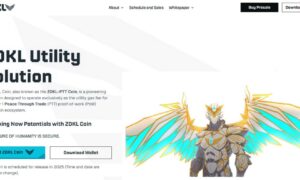Welcome to the world of Tezos, where innovation and blockchain technology converge to unlock endless possibilities. In this blog post, we invite you on a journey to unravel the true potential of Tezos, an extraordinary decentralized platform built for smart contracts and dApps. Whether you’re a cryptocurrency enthusiast or simply curious about the future of digital finance, join us as we dive deep into understanding Tezos’ purpose and explore its fascinating applications that are reshaping industries worldwide.
Introduction to Tezos
Tezos is a decentralized blockchain platform that has been gaining significant attention in the world of digital currencies. It was created in 2018 by Arthur Breitman and Kathleen Breitman, who wanted to develop an innovative and secure platform for building decentralized applications (Dapps). Tezos aims to overcome some of the limitations faced by other blockchain platforms, such as scalability issues, governance problems, and upgradeability concerns.
At its core, Tezos is a self-amending blockchain that allows for on-chain governance through community consensus. This means that any proposed changes or upgrades to the network can be voted upon and implemented without causing forks or disruptions in the system. This unique feature sets Tezos apart from other cryptocurrencies and makes it a promising platform for long-term development.
A Brief History of Tezos
Tezos is a decentralized blockchain platform that was founded in 2014 by Arthur Breitman and his wife, Kathleen Breitman. The project gained widespread attention when it launched one of the largest initial coin offerings (ICOs) in history, raising over $232 million in just 13 days.
The idea for Tezos began with the Breitmans’ frustration with the lack of flexibility and adaptability of existing blockchain platforms. They believed that these limitations hindered the potential for innovation and progress within the industry. Thus, they set out to create a self-amending cryptocurrency platform that would allow for smooth upgrades and improvements without causing disruptions or splits within the community.
In order to achieve this goal, Tezos utilizes an on-chain governance system where every stakeholder has a say in decision-making processes through a formal voting process. This helps to avoid contentious hard forks, which have caused divisions among other cryptocurrencies like Bitcoin and Ethereum.
The development of Tezos was not without its challenges. In 2017, there was a dispute between the founders and Johann Gevers, who was leading the foundation and responsible for managing the funds raised during the ICO. This led to delays in development and legal battles, but ultimately resulted in Gevers stepping down from his role.
Understanding the Purpose of Tezos
Tezos is a decentralized blockchain platform that aims to revolutionize the way smart contracts and decentralized applications (DApps) are created and executed. But what sets Tezos apart from other blockchain platforms? To truly understand its potential, it is important to first understand the purpose of Tezos.
At its core, the purpose of Tezos is to address the challenges faced by traditional blockchains, such as scalability, governance, and flexibility. By focusing on these key areas, Tezos seeks to provide a more efficient and sustainable platform for building DApps and executing smart contracts.
One of the main goals of Tezos is scalability—the ability to handle a large number of transactions without compromising on speed or network congestion. This is achieved through its unique self-amending mechanism, which allows for seamless upgrades without hard forks. Hard forks are often seen in other blockchain networks as a necessary but disruptive process that can result in community fragmentation and slow down progress. With Tezos’ self-amending feature, proposed changes can be implemented smoothly without causing any disruptions or creating separate branches within the network.
Another crucial aspect that sets Tezos apart is its emphasis on governance. The platform has been designed with a strong focus on community decision-making processes through formalized voting systems. This means that all stakeholders have an active role in shaping how the network evolves over time, from protocol upgrades to new features being added. This democratic approach ensures that all voices within the community are heard, promoting inclusivity and transparency in decision-making.
Real-Life Applications of Tezos
Tezos, a decentralized blockchain platform, has been gaining significant attention in the cryptocurrency world due to its unique features and potential applications. While its purpose may seem similar to other blockchain platforms such as Ethereum or Bitcoin, Tezos offers several distinct advantages that make it stand out from the rest. In this section, we will explore some real-life applications of Tezos and how it is revolutionizing various industries.
1. Decentralized Finance (DeFi)
One of the most prominent real-life applications of Tezos is in the field of decentralized finance (DeFi). DeFi refers to a financial system built on top of blockchain technology that eliminates intermediaries like banks and allows for peer-to-peer transactions. Tezos’ smart contract capabilities make it an ideal platform for building DeFi protocols such as lending, borrowing, and trading platforms.
Tezos’ self-amending feature also ensures that any updates or changes in the protocol are proposed and implemented efficiently without causing disruptions or hard forks. This makes it more stable and less prone to security vulnerabilities compared to other DeFi platforms.
2. Tokenization
Tokenization is another real-life application of Tezos that has gained significant traction in recent years. It involves converting real-world assets into digital tokens on a blockchain network, making them easily tradable and divisible.
Tezos’ smart contracts allow for the creation of tokens with specific attributes, such as transfer restrictions or dividend distribution mechanisms. This opens up opportunities for asset tokenization across various industries, such as real estate, art, and commodities.
3. Voting Systems
Tezos’ on-chain governance mechanism makes it an ideal platform for implementing secure and transparent voting systems. Governments or organizations can leverage Tezos to conduct elections, polls, or other decision-making processes without the need for intermediaries.
The immutability of the blockchain ensures that the results cannot be tampered with, providing a more trustworthy and efficient alternative to traditional voting systems.
4. Supply Chain Management
Supply chain management is another area where Tezos can make a significant impact. With its smart contract functionality, businesses can track and manage their supply chains in a transparent and automated manner. This can help reduce fraud, increase efficiency, and improve the traceability of products from manufacturer to consumer.
Furthermore, the self-amending feature of Tezos allows for updates and improvements to be made to the supply chain protocol without disrupting ongoing operations.
5. Gaming
Tezos’ smart contract capabilities also make it suitable for developing decentralized gaming applications. These games can use non-fungible tokens (NFTs) to represent in-game assets such as characters or items, making them unique and tradable on secondary markets.
How is Tezos different from other blockchain platforms?
Tezos is a relatively new blockchain platform that has been gaining increasing attention and popularity in the cryptocurrency community. As with any emerging technology, it is natural to compare Tezos with other established blockchain platforms, such as Bitcoin and Ethereum. However, Tezos sets itself apart from these platforms in several key ways.
1. Governance Model: One of the most significant differences between Tezos and other blockchain platforms is its unique self-amending governance model. While most blockchains are controlled by a small group of developers or miners, Tezos empowers its token holders to participate in the decision-making process for upgrades and changes to the network. This democratic approach ensures that all stakeholders have a say in the evolution of the platform, promoting a more decentralized and fair system.
2. Flexibility and Upgradability: Unlike other blockchains where upgrades require hard forks, which can lead to network disruptions and divide communities, Tezos allows for seamless protocol upgrades through its on-chain governance system. This means that the platform can easily adapt to changing market trends without causing any major disruptions or divisions within its community.
3. Baking System: In contrast to traditional mining systems used by many blockchain platforms, Tezos uses a baking system for validating transactions on its network. Bakers are responsible for creating new blocks on the chain and are incentivized through rewards rather than transaction fees, like in traditional mining systems. This ensures more stable transaction fees while also reducing the centralization risks posed by large mining pools.
4. Smart Contract Language: The programming language used for writing smart contracts on Tezos is called Michelson. Unlike Solidity, which is used on Ethereum, Michelson is a functional programming language that allows for more secure and formal verification of smart contracts. This makes the platform less prone to bugs and vulnerabilities.
5. On-Chain Governance Fund: Tezos has a unique on-chain governance fund that is designed to support the development of the network. This fund is continuously replenished through a small percentage of transaction fees and block rewards, ensuring long-term sustainability and incentivizing developers to contribute to the platform’s growth.
Conclusion
The future of Tezos holds immense potential for revolutionizing the crypto industry. With its unique self-amending protocol, it has already gained attention and support from various investors and developers. Its purpose as a blockchain platform for smart contracts and decentralized applications makes it stand out among other cryptocurrencies.


































